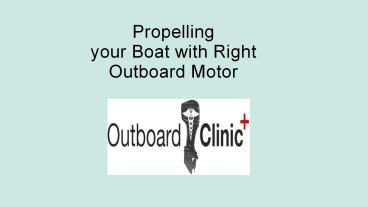Propelling your Boat with Right Outboard Motor - PowerPoint PPT Presentation
Title:
Propelling your Boat with Right Outboard Motor
Description:
The most common motorized method of running a small watercraft is with the help of an outboard motor. These motors are a self-contained unit with an engine, propeller, subsidiary systems. It is fixed at the rear side of the watercraft. Outboard motors provide propulsion and steering control as they are designed to be able to be pivoted on their mountings, thus it helps to control the direction of the boat in which the propeller thrusts. For details visit, – PowerPoint PPT presentation
Number of Views:91
Title: Propelling your Boat with Right Outboard Motor
1
Propelling your Boat with Right Outboard Motor
2
Even when the engine is not providing propulsion,
the transmission leg takes charge and acts as a
rudder, and it is used to direct the watercraft.
The mounting of the outboard helps the engine to
move forward to progress the transmission and
propeller shaft out of the water to avoid
collecting seaweed or striking various underwater
hazards such as rocks and other particles.
3
Small outboard motors are completely
self-contained that have integral fuel tanks
and controls and are steered using a "tiller"
that is directly connected to the system.
The power provided by this small outboard motor
is sufficient to move a small boat at around 9mph
which is much faster than what is possible with
oars, they can weigh as little as 12kg.
4
Their lightweight and portable nature of small
outboards allow them to be removed simply by
loosening their mounting clamps.
Starting smaller engines usually involves a
manual pull start ignition system whereas larger
engines often have electric starts, like that in
a car.
5
Large outboard engines have been designed in a
way that has sufficient power to be used on
watercraft that is nine meters long or greater.
Electric outboards are produced more recent times
and are used for specialized applications such as
fishing, and many more.
6
It is beneficial in fishing because of its
quietness and zero emissions.
Diesel outboards are available and used by some
people, however, their weight and cost make them
undesirable for most of the applications.
7
The Pump-jet propulsion outboard engines have
been produced by changing the conventional
propeller design.
Like many other pump-kit propulsion systems, they
boast virtually no cavitation, allowing the boat
to move carefully, and are operated in very
shallow water without fear of damaging the engine.































